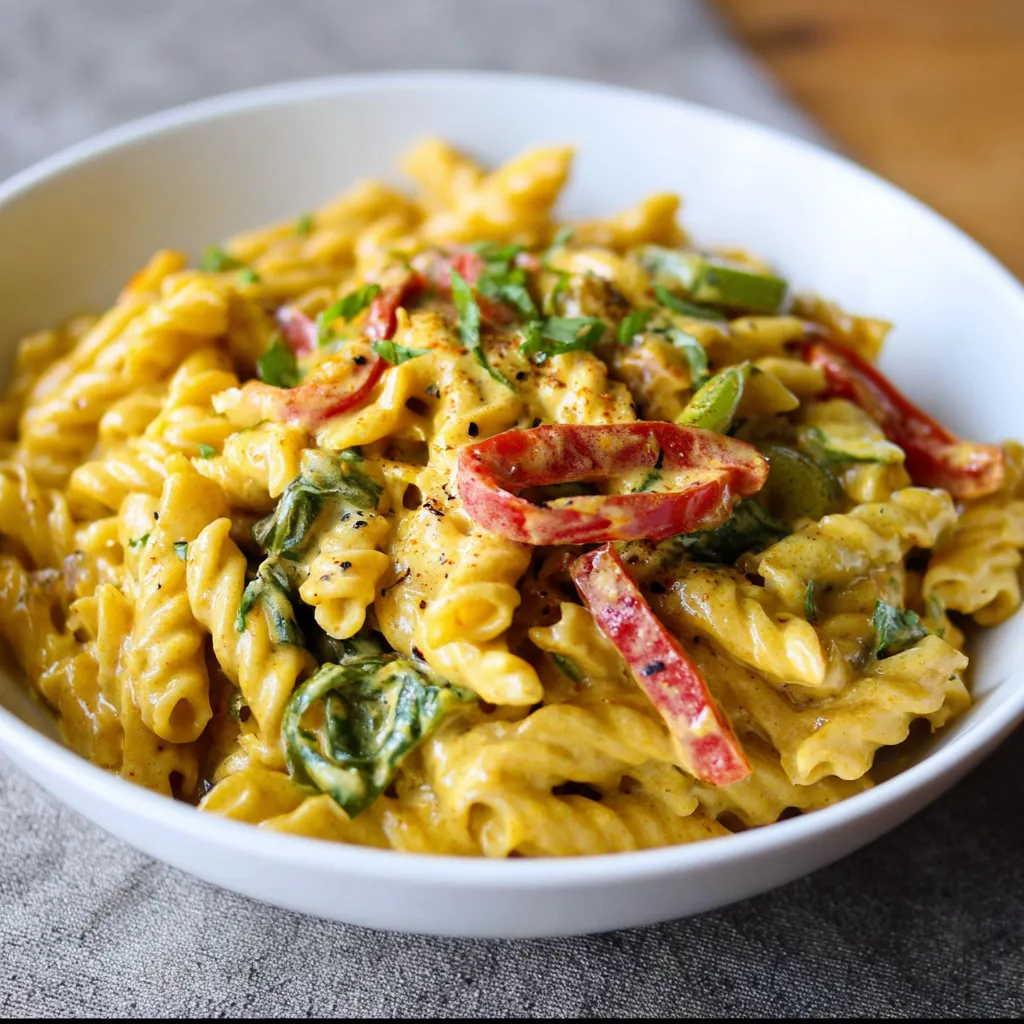Table of Contents
Rasta pasta recipe – three words that instantly transport me back to a tiny beachside kitchen in Jamaica, where I first discovered this incredible fusion dish that would forever change how I think about comfort food. I was twenty-two, fresh out of culinary school, and convinced I knew everything about cooking. Then I met Miss Ruby, a local cook who ran a small restaurant tucked away from the tourist crowds, and she introduced me to this vibrant, soul-warming dish that married the boldest Caribbean flavors with the comfort of Italian pasta.
I still remember the first bite – the way the creamy coconut milk sauce enveloped perfectly cooked penne, how the jerk seasoning danced on my tongue with just the right amount of heat, and how the colorful bell peppers added sweetness and crunch to every forkful. Miss Ruby laughed at my wide-eyed expression and said, “Child, this is what happens when cultures cook together with love.” That moment sparked my lifelong passion for fusion cuisine and taught me that the best recipes aren’t just about ingredients – they’re about stories, connections, and the magic that happens when different culinary traditions embrace each other.
Now, years later, this creamy rasta pasta recipe has become my go-to dish for everything from busy weeknight dinners to impressing guests who think they’ve tried everything. I’ve perfected the technique through countless experiments in my own kitchen, learning how to balance the fiery jerk seasoning with the cooling coconut milk, and discovering that this easy rasta pasta recipe is infinitely adaptable. Whether you’re craving a hearty jerk chicken rasta pasta recipe, a fresh shrimp rasta pasta recipe, or want to keep it plant-based with a vegan rasta pasta recipe, this dish delivers authentic Caribbean flavors that will make your kitchen smell like paradise and your family beg for seconds.
What Is Rasta Pasta?
Rasta pasta recipe is a beloved Caribbean pasta dish that originated in Jamaica during the 1980s, created by chef Lorraine Washington at the Pasta Plus restaurant in Kingston. This innovative fusion dish combines the fiery heat of traditional Jamaican jerk seasoning with Italian pasta cooking techniques, creating a unique culinary experience that celebrates both cultures.
The dish gets its name from the vibrant red, yellow, and green colors of the bell peppers, which mirror the colors of the Rastafarian flag. These colors also represent the Pan-African movement, making this Jamaican rasta pasta recipe not just delicious but culturally significant. The combination of coconut milk pasta with jerk seasoning creates a harmonious balance of heat, creaminess, and authentic Jamaican flavor that has made this dish a staple in Caribbean cuisine.
What makes this Caribbean pasta dish so special is how it transforms simple ingredients into something extraordinary. The jerk seasoning, traditionally used for grilling meats, adds depth and complexity to the creamy sauce, while the bell peppers provide sweetness and crunch. This fusion approach has influenced countless variations, from vegetarian rasta pasta recipe to seafood versions, proving that great flavors transcend cultural boundaries.
Ingredients You’ll Need
Creating the perfect rasta pasta recipe starts with gathering quality ingredients that will deliver authentic Caribbean flavors. This recipe is designed to be flexible, allowing you to customize based on your dietary preferences and what you have available in your pantry.
For the Pasta Base:
- 1 pound penne or fettuccine pasta (use gluten-free if needed)
- 2 tablespoons olive oil
- 1 large onion, sliced
- 1 red bell pepper, julienned
- 1 yellow bell pepper, julienned
- 1 green bell pepper, julienned
- 4 cloves garlic, minced
- 2-3 tablespoons jerk seasoning (adjust to taste)
- 1 can (14 oz) coconut milk or 1 cup heavy cream
- 1/2 cup chicken or vegetable broth
- Salt and black pepper to taste
- 2 green onions, chopped (for garnish)
- Fresh cilantro or parsley (for garnish)
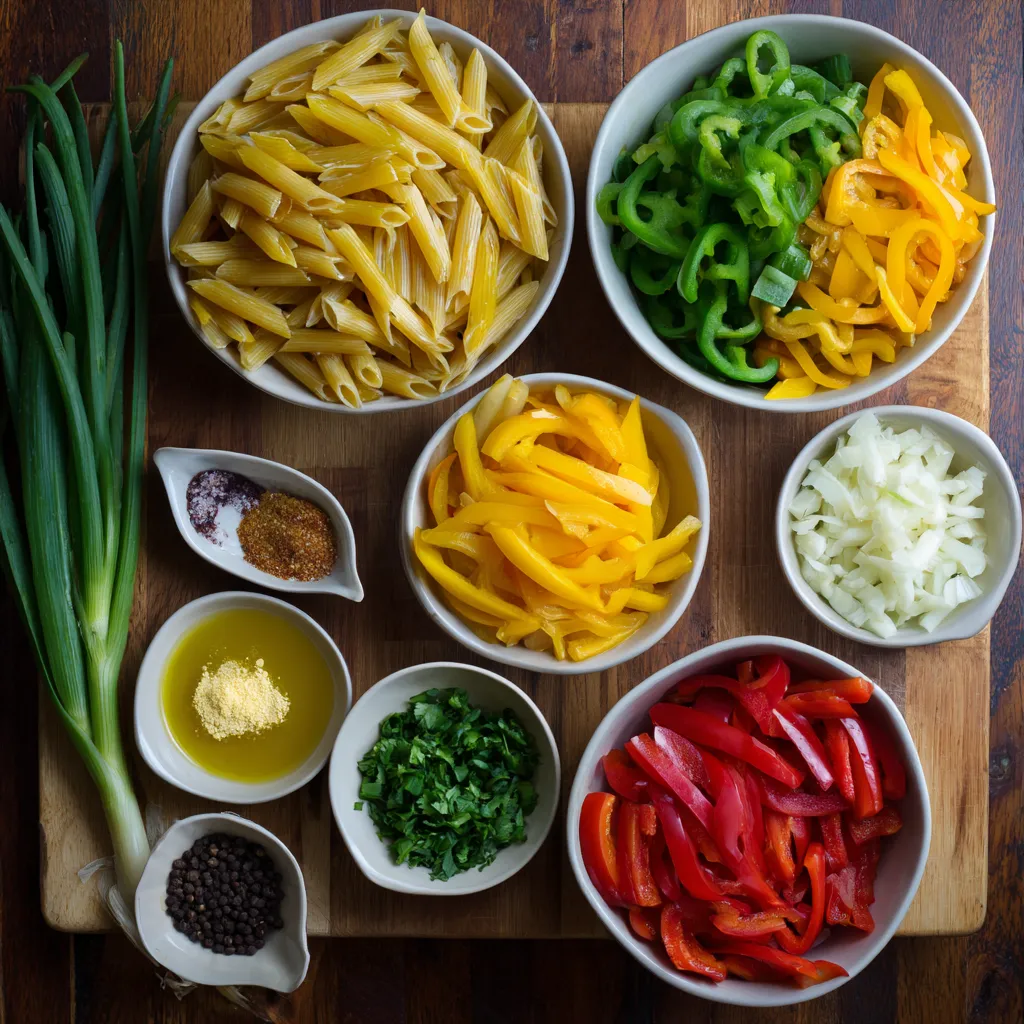
Protein Options:
For jerk chicken rasta pasta: 1 1/2 pounds boneless chicken thighs or breasts, cut into strips For shrimp rasta pasta recipe: 1 1/2 pounds large shrimp, peeled and deveined For vegan rasta pasta recipe: 1 block extra-firm tofu, cubed, or 2 cups jackfruit
Vegan and Dairy-Free Swaps:
When preparing a vegan rasta pasta recipe, substitute heavy cream with full-fat coconut milk for the richest texture. Coconut cream works exceptionally well, providing the luxurious mouthfeel that makes this dish so satisfying. For additional protein, consider using marinated tofu, tempeh, or even chickpeas seasoned with jerk spices.
The key to an authentic rasta pasta recipe with coconut milk is using high-quality jerk seasoning. You can purchase pre-made jerk seasoning or create your own blend using allspice, thyme, scotch bonnet peppers, garlic powder, onion powder, and brown sugar. This spice blend is what gives the dish its distinctive Caribbean character and separates it from ordinary pasta dishes.
How to Make Rasta Pasta Recipe Step-by-Step
This easy rasta pasta recipe comes together in just 30 minutes, making it perfect for busy weeknights when you want something special without spending hours in the kitchen. The key to success lies in proper timing and building layers of flavor.
Step 1: Prepare the Pasta
Start by bringing a large pot of salted water to a rolling boil. Add your pasta and cook according to package directions until al dente. Reserve 1 cup of pasta water before draining, as this starchy liquid will help bind the sauce to the pasta later. Drain the pasta and set aside.
Step 2: Season and Cook the Protein
If using chicken, season the strips generously with jerk seasoning, salt, and pepper. Heat 1 tablespoon of olive oil in a large skillet over medium-high heat. Cook the chicken for 6-8 minutes until golden brown and cooked through. Remove and set aside. For shrimp, season and cook for 2-3 minutes per side until pink and cooked through. For tofu, press out excess water, cube, and cook until golden on all sides.
Step 3: Sauté the Vegetables
In the same skillet, add the remaining olive oil. Add sliced onions and cook for 3-4 minutes until they begin to soften. Add the colorful bell peppers and cook for another 5-6 minutes until they’re tender-crisp. The peppers should retain some bite while being cooked through. Add minced garlic and cook for an additional minute until fragrant.
Step 4: Build the Sauce
Sprinkle the jerk seasoning over the vegetables and stir to coat evenly. Cook for 1-2 minutes to toast the spices and release their oils. Slowly pour in the coconut milk or heavy cream, stirring constantly to prevent curdling. Add the broth and bring the mixture to a gentle simmer. Let it cook for 3-4 minutes until the sauce begins to thicken slightly.
Step 5: Combine and Finish
Return the cooked protein to the skillet and stir to combine with the sauce. Add the cooked pasta and toss everything together, adding pasta water as needed to achieve a silky consistency. Taste and adjust seasoning with salt, pepper, or additional jerk seasoning. The sauce should coat the pasta beautifully while maintaining a creamy texture.
Step 6: Garnish and Serve
Remove from heat and garnish with chopped green onions and fresh cilantro or parsley. Serve immediately while hot, with additional jerk seasoning on the side for those who want extra heat.
This creamy rasta pasta recipe technique ensures that every element is perfectly cooked and well-seasoned. The key is not to rush the process and to taste as you go, adjusting the spice level to your preference.
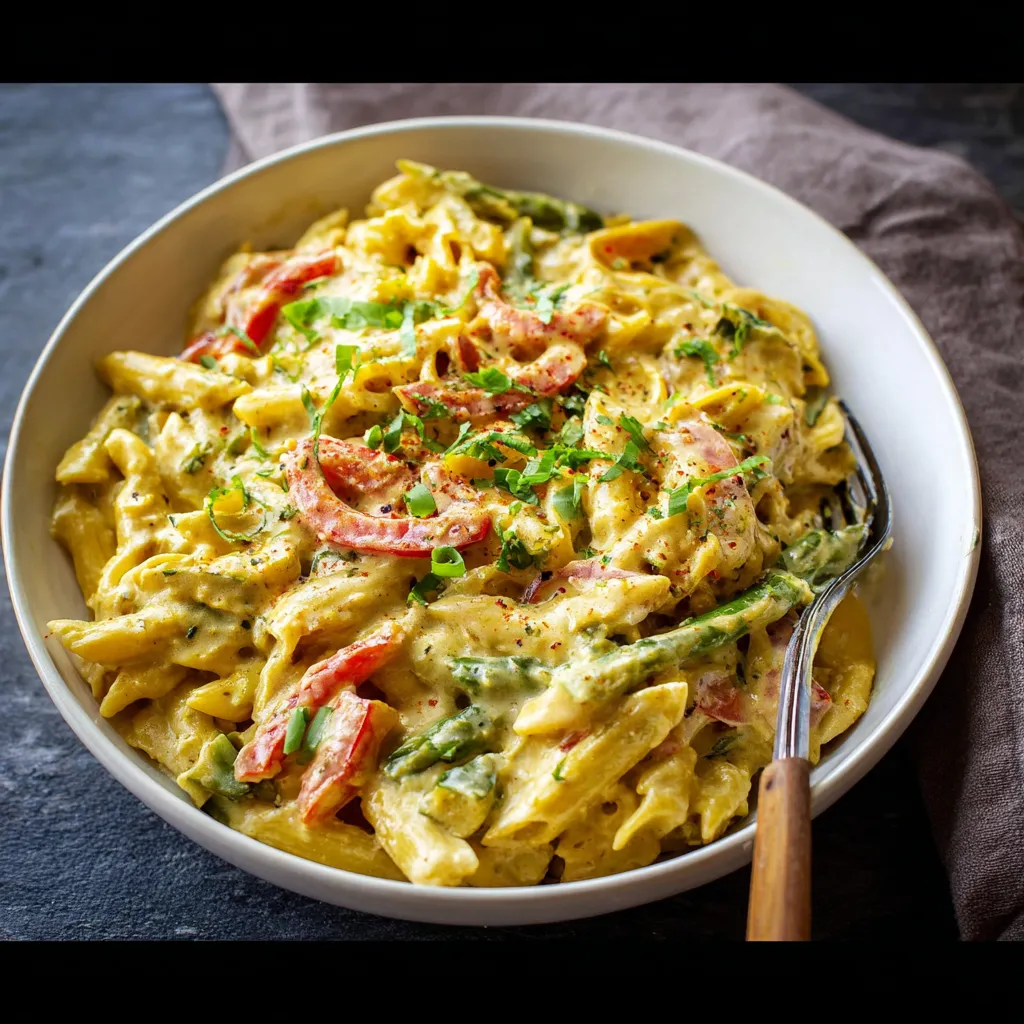
Variations & Substitutions
The beauty of this rasta pasta recipe lies in its adaptability. Whether you’re accommodating dietary restrictions, using what’s available in your pantry, or simply wanting to try something new, there are countless ways to customize this dish while maintaining its authentic Caribbean character.
Vegan Rasta Pasta Recipe
Creating a vegan rasta pasta recipe is simple and delicious. Replace any animal proteins with marinated tofu, tempeh, or jackfruit. Use full-fat coconut milk instead of heavy cream for the richest, most authentic flavor. Add extra vegetables like zucchini, mushrooms, or spinach to boost nutrition and create a more substantial dish. Nutritional yeast can add a subtle cheesy flavor that complements the jerk seasoning beautifully.
Shrimp Rasta Pasta Recipe
For a shrimp rasta pasta recipe, use large shrimp (16-20 count) for the best texture. Season the shrimp with jerk seasoning before cooking, and don’t overcook them to maintain their tender texture. Shrimp pairs exceptionally well with the coconut milk base, creating a dish reminiscent of Caribbean coconut shrimp but in pasta form.
Protein Variations
Beyond chicken and shrimp, this recipe works wonderfully with other proteins. Try jerk-seasoned pork tenderloin, beef strips, or even lamb for a unique twist. For seafood lovers, scallops, crab, or a mix of seafood creates an impressive dish perfect for entertaining.
Spice Level Adjustments
If you prefer a milder version, reduce the jerk seasoning and add more coconut milk or cream to temper the heat. For those who love extra spice, add diced scotch bonnet peppers or jalapeños, or incorporate hot sauce into the final dish. The beauty of this recipe is that you can adjust the heat level to suit your family’s preferences.
Gluten-Free and Low-Carb Options
Use gluten-free pasta made from rice, quinoa, or legumes for those with gluten sensitivities. For a low-carb version, substitute the pasta with spiralized zucchini, spaghetti squash, or shirataki noodles. These alternatives work well with the creamy sauce and maintain the dish’s satisfying character.
Tips for the Best Rasta Pasta
Creating the best rasta pasta recipe requires attention to detail and understanding how the various components work together. These professional tips will help you achieve restaurant-quality results every time.
Mastering the Jerk Seasoning
The heart of authentic rasta pasta recipe lies in the jerk seasoning. If possible, use freshly ground spices rather than pre-ground versions, as they retain more flavor and potency. Toast whole spices like allspice berries and coriander seeds before grinding for maximum flavor impact. When adding jerk seasoning to the dish, cook it briefly with the vegetables to bloom the spices and prevent any raw, powdery taste.
Achieving the Perfect Sauce Consistency
The sauce should coat the pasta without being too thick or thin. If using coconut milk, shake the can well before opening to ensure the cream and liquid are properly combined. If the sauce seems too thick, add pasta water gradually until you reach the desired consistency. The starch in pasta water helps bind the sauce to the noodles better than plain water or broth.
Pasta Cooking Technique
Cook the pasta just until al dente, as it will continue cooking slightly when combined with the hot sauce. Overcooked pasta will become mushy and won’t hold up well to the bold flavors of the jerk seasoning. Reserve pasta water before draining, as this starchy liquid is crucial for achieving the perfect sauce consistency.
Balancing Heat and Creaminess
The key to a successful creamy rasta pasta recipe is balancing the heat from the jerk seasoning with the coolness of the coconut milk or cream. If the dish becomes too spicy, add more coconut milk or a splash of regular milk. If it’s too mild, gradually add more jerk seasoning, tasting as you go.
Vegetable Preparation
Cut all vegetables uniformly to ensure even cooking. The bell peppers should be julienned (cut into thin strips) rather than diced, as this creates better texture and visual appeal. Don’t overcook the vegetables; they should retain some crunch to provide textural contrast to the creamy sauce and tender pasta.
Final Seasoning
Always taste and adjust seasoning at the end. The dish should have a balance of heat, saltiness, and richness. Don’t forget to season with salt and black pepper, as these enhance all the other flavors in the dish.
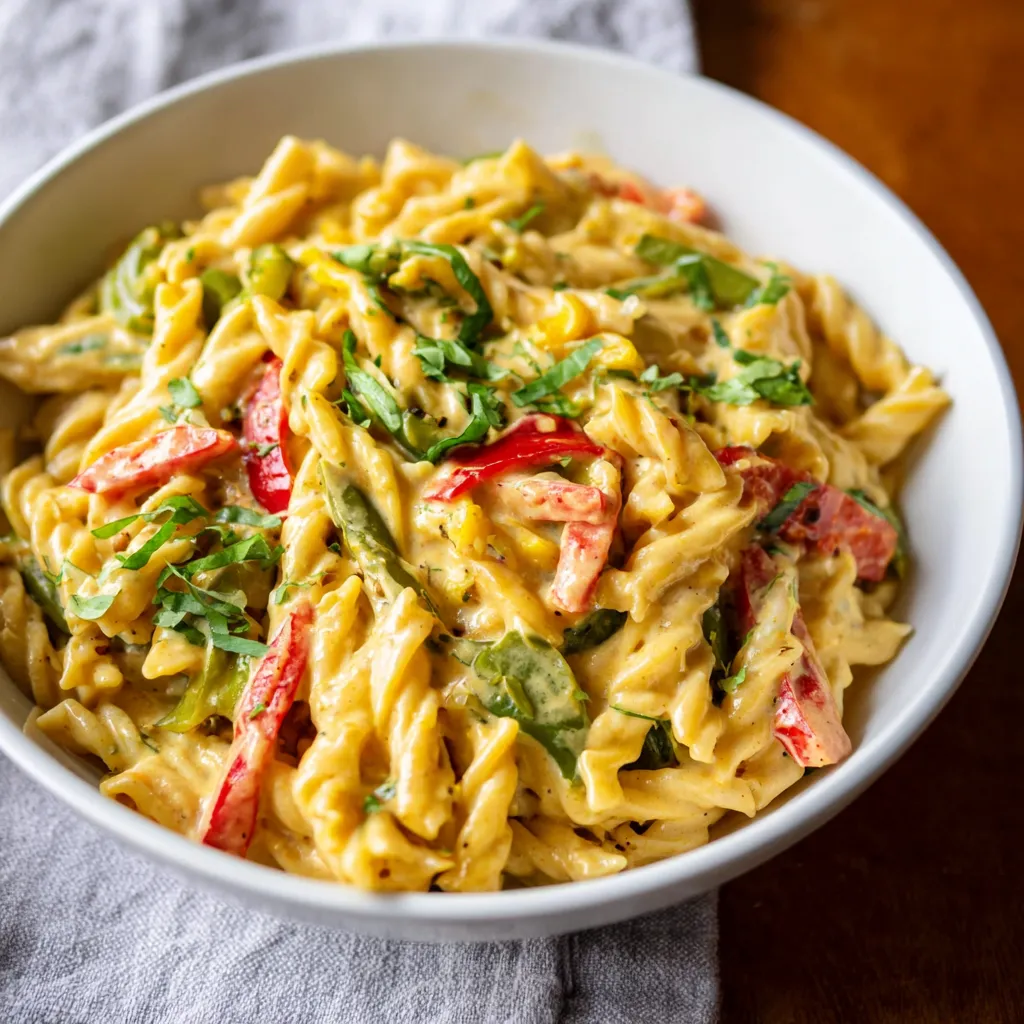
Storage, Reheating & Make-Ahead Tips
Proper storage and reheating techniques ensure your rasta pasta recipe remains delicious even as leftovers. Understanding how to handle the coconut milk or cream-based sauce will help maintain the dish’s quality and prevent separation or curdling.
Refrigerator Storage
Store leftover rasta pasta recipe in airtight containers in the refrigerator for up to 3-4 days. The coconut milk base actually improves in flavor after a day, as the spices have more time to meld together. However, the pasta may absorb some of the sauce, so you might need to add a splash of broth or coconut milk when reheating.
Freezer Storage
While pasta dishes with cream or coconut milk can be frozen, the texture may change slightly upon thawing. If you plan to freeze portions, slightly undercook the pasta initially and use a bit less liquid in the sauce. Freeze in individual portions for up to 2 months. Thaw overnight in the refrigerator before reheating.
Reheating Methods
For best results, reheat gently on the stovetop over low heat, stirring frequently and adding liquid as needed. Microwave reheating is possible but requires careful attention to prevent the sauce from separating. Heat in 30-second intervals, stirring between each interval, and add a splash of coconut milk or broth if the sauce seems too thick.
Make-Ahead Strategies
You can prepare components ahead of time to streamline dinner preparation. Cook and season the protein, prepare the vegetables, and even make the sauce base up to 24 hours in advance. Store each component separately and combine when ready to serve. This approach is particularly useful for jerk chicken rasta pasta recipe preparation for entertaining.
Meal Prep Considerations
This dish works well for meal prep, though it’s best consumed within 2-3 days for optimal texture. Prepare individual portions in containers, leaving space for the pasta to expand as it absorbs the sauce. When meal prepping, consider preparing the sauce and protein separately from the pasta, combining them just before eating.
Frequently Asked Questions
Can I make this ahead of time? Yes, you can prepare components of this rasta pasta recipe ahead of time. Cook the protein and prepare the sauce base up to 24 hours in advance, storing them separately in the refrigerator. Cook the pasta fresh when ready to serve for the best texture. The flavors actually improve after sitting for a few hours, making this an excellent option for entertaining.
What’s the best protein for this dish? The jerk chicken rasta pasta recipe is the most traditional and popular version, using boneless chicken thighs for the best flavor and texture. However, shrimp works beautifully and cooks quickly, making it perfect for weeknight dinners. For vegetarian options, firm tofu or tempeh seasoned with jerk spices provides excellent protein and absorbs the flavors wonderfully.
Is this dish spicy? The spice level depends on the jerk seasoning you use and how much you add. Most commercial jerk seasonings provide moderate heat with complex flavor. You can always start with less seasoning and add more to taste. The coconut milk or cream helps balance the heat, creating a dish that’s flavorful rather than overwhelmingly spicy.
Can I use regular milk instead of coconut milk? While coconut milk provides authentic Caribbean flavor and richness, you can substitute heavy cream or even whole milk if needed. However, coconut milk is preferred for its ability to complement the jerk seasoning and create the most authentic taste. For a vegan rasta pasta recipe, coconut milk is essential.
What type of pasta works best? Penne and fettuccine are the most popular choices because they hold the sauce well. Penne’s tubular shape traps the creamy sauce, while fettuccine’s flat surface provides excellent sauce coverage. Other good options include rigatoni, rotini, or any pasta shape that can hold chunky sauces.
How do I make my own jerk seasoning? Combine 2 tablespoons allspice berries, 1 tablespoon dried thyme, 1 teaspoon ground cinnamon, 1 teaspoon ground nutmeg, 1 teaspoon garlic powder, 1 teaspoon onion powder, 1 teaspoon brown sugar, 1 teaspoon salt, and 1/2 teaspoon cayenne pepper. Adjust heat level to taste. Grind whole spices for the best flavor.
Can I make this gluten-free? Absolutely! Use your favorite gluten-free pasta and ensure your jerk seasoning doesn’t contain any gluten-containing ingredients. The rest of the recipe is naturally gluten-free, making it easy to adapt for those with gluten sensitivities.
How do I prevent the coconut milk from curdling? Use full-fat coconut milk and avoid high heat when adding it to the pan. Stir constantly and bring to a gentle simmer rather than a rolling boil. If the sauce does separate, remove from heat and whisk vigorously, or blend briefly with an immersion blender to re-emulsify.
What vegetables can I add? While bell peppers are traditional, you can add zucchini, mushrooms, spinach, or cherry tomatoes. Add hardy vegetables like zucchini with the peppers, and delicate greens like spinach at the very end of cooking. The key is maintaining the colorful, vibrant appearance that gives rasta pasta recipe its name.
How do I store leftover jerk seasoning? Store homemade jerk seasoning in an airtight container in a cool, dry place for up to 6 months. Whole spices maintain their potency longer than ground spices, so grind only what you need for the best flavor. Label containers with the date to ensure freshness.
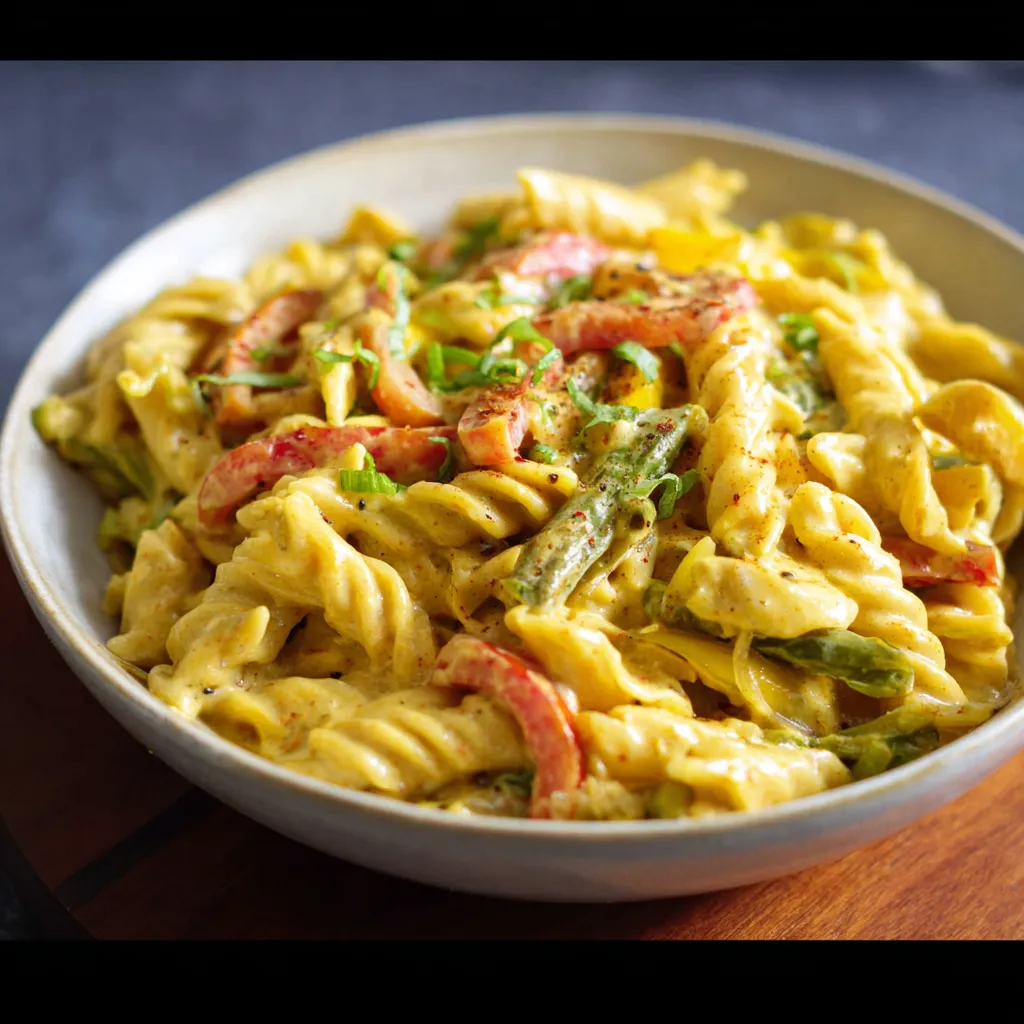
Try These Recipes Next!
If you loved this rasta pasta recipe, explore these complementary Caribbean-inspired dishes that will expand your culinary horizons and bring more island flavors to your kitchen.
Jerk Chicken Skewers make an excellent appetizer or main course that pairs beautifully with the flavors in rasta pasta. The same jerk seasoning creates consistency across your meal, and the grilled preparation adds smoky depth that complements the creamy pasta dish.
Vegan Jambalaya offers another fusion approach, combining Caribbean and Creole flavors in a one-pot dish that’s perfect for meal prep. Like rasta pasta, it’s highly customizable and can accommodate various dietary preferences while delivering bold, satisfying flavors.
Coconut Rice and Beans provides the perfect side dish for rasta pasta, or can stand alone as a complete meal. The coconut milk base mirrors the pasta’s creamy richness, while the rice and beans add protein and fiber for a well-rounded meal.
Caribbean Curry Chicken brings similar warming spices and coconut milk richness, offering variety while maintaining the flavor profile your family has come to love. Serve over rice or with roti for an authentic Caribbean experience.
Plantain Fritters make an excellent appetizer or side dish, adding sweetness and texture that balances the spicy, creamy pasta. These crispy treats are simple to make and provide an authentic Caribbean touch to your meal.
These recipes work together to create a complete Caribbean-inspired menu that will transport your dining table to the islands. Each dish shares common ingredients and flavor profiles with rasta pasta, making grocery shopping efficient while providing variety in your meal planning.
This authentic rasta pasta recipe delivers restaurant-quality results with simple ingredients and techniques. Whether you choose the classic jerk chicken rasta pasta recipe, opt for a vegan rasta pasta recipe, or try the shrimp rasta pasta recipe, you’ll create a memorable meal that celebrates the vibrant flavors of the Caribbean. The combination of spicy jerk seasoning, creamy coconut milk, and colorful vegetables creates a dish that’s as beautiful as it is delicious.
Remember to adjust the spice level to your preference, use the freshest ingredients possible, and don’t be afraid to make this recipe your own. The beauty of Caribbean cuisine lies in its flexibility and the joy of sharing flavorful food with family and friends. Enjoy your culinary journey to the islands!
Recipe Schema Metadata:
- Recipe Name: Rasta Pasta Recipe (Authentic, Creamy & Easy)
- Description: A vibrant Caribbean pasta dish featuring jerk seasoning, coconut milk, and colorful bell peppers
- Prep Time: 15 minutes
- Cook Time: 15 minutes
- Total Time: 30 minutes
- Servings: 4-6
- Difficulty: Easy
- Cuisine: Caribbean-Italian Fusion
- Diet: Customizable (vegetarian, vegan, gluten-free options available)
- Main Ingredients: Pasta, jerk seasoning, coconut milk, bell peppers, protein of choice
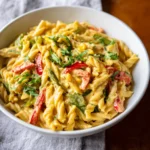
Rasta Pasta Recipe (Authentic, Creamy & Easy)
- Total Time: 30
- Yield: 4-6 1x
Description
This vibrant rasta pasta recipe brings together bold Jamaican jerk seasoning with creamy coconut milk and colorful bell peppers. A perfect fusion of Caribbean and Italian flavors that’s ready in just 30 minutes. Easily customizable with chicken, shrimp, or vegan options.
Ingredients
- 1 pound penne or fettuccine pasta
- 2 tablespoons olive oil
- 1 large onion, sliced
- 1 red bell pepper, julienned
- 1 yellow bell pepper, julienned
- 1 green bell pepper, julienned
- 4 cloves garlic, minced
- 2–3 tablespoons jerk seasoning
- 1 can (14 oz) coconut milk or 1 cup heavy cream
- 1/2 cup chicken or vegetable broth
- 1 1/2 pounds boneless chicken thighs, cut into strips (or protein of choice)
- Salt and black pepper to taste
- 2 green onions, chopped (for garnish)
- Fresh cilantro or parsley (for garnish)
Instructions
- Cook the pasta: Bring a large pot of salted water to boil. Cook pasta according to package directions until al dente. Reserve 1 cup pasta water before draining.
- Season and cook protein: Season chicken strips with jerk seasoning, salt, and pepper. Heat 1 tablespoon olive oil in a large skillet over medium-high heat. Cook chicken 6-8 minutes until golden brown and cooked through. Remove and set aside.
- Sauté vegetables: Add remaining oil to skillet. Cook onions 3-4 minutes until softened. Add bell peppers and cook 5-6 minutes until tender-crisp. Add garlic and cook 1 minute until fragrant.
- Build the sauce: Sprinkle jerk seasoning over vegetables and cook 1-2 minutes. Slowly add coconut milk, stirring constantly. Add broth and simmer 3-4 minutes until sauce thickens slightly.
- Combine: Return cooked protein to skillet. Add pasta and toss, adding pasta water as needed for silky consistency. Taste and adjust seasoning.
- Serve: Garnish with green onions and cilantro. Serve immediately while hot.
Notes
- Protein variations: Use shrimp (cook 2-3 minutes per side), tofu, or tempeh for different options
- Vegan version: Use coconut milk and plant-based protein like seasoned tofu or jackfruit
- Spice level: Adjust jerk seasoning to taste – start with less and add more as needed
- Make-ahead: Components can be prepared separately up to 24 hours in advance
- Storage: Refrigerate leftovers up to 3-4 days. Reheat gently with added liquid if needed
- Prep Time: 15
- Cook Time: 15
- Category: Main Course
- Method: Stovetop
- Cuisine: Caribbean-Italian Fusion
Nutrition
- Serving Size: 1 serving (1/6 of recipe)
- Calories: 485
- Sugar: 8g
- Sodium: 680mg
- Fat: 18g
- Saturated Fat: 12g
- Unsaturated Fat: 5g
- Trans Fat: 0g
- Carbohydrates: 58g
- Fiber: 4g
- Protein: 28g
- Cholesterol: 75mg
Keywords: rasta pasta recipe, creamy rasta pasta recipe, jerk chicken rasta pasta recipe, rasta pasta recipe with shrimp, easy rasta pasta recipe, vegan rasta pasta recipe, rasta pasta recipe with coconut milk, caribbean pasta dish, spicy creamy pasta, jamaican rasta pasta recipe
